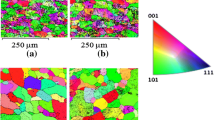Abstract
Incremental sheet forming (ISF) consists of deforming the sheet, through a spherical punch, punctually and progressively until it reaches the desired geometry. Compared to the conventional process, the ISF can achieve much higher levels of formability. But the stresses and residual strains are often pushed to the limit on the path, producing a piece with brittle behavior, which is not desirable for applications in engineering. To work around this inconvenience, one solution would be to perform the conformation at high temperatures, a process known in engineering as hot forming. This study aims to evaluate the behavior of the state of stresses and strains in the hot incremental sheet forming of 1050 aluminum alloy, with and without pre-heating, using the finite element method. This behavior has been studied by numerical simulation, using the software RADIOSS, which has a suitable formulation for inserting the effects of temperature and strain rate in the material. The results show a decline in the forces for electric hot incremental sheet forming preheated (EHISFP) compared to the electric hot incremental sheet forming (EHISF). Moreover, for these same cases, there was a gain in relation to the geometric precision on average more than 4%.
Similar content being viewed by others
References
Göttmann A, Bailly D, Bergweiler G, Bambach M, Stollenwerk J, Hirt G, Loosen P (2013) A novel approach for temperature control in ISF supported by laser and resistance heating. Int J Adv Manuf Technol 67:2195–2205. doi:10.1007/s00170-012-4640-z
Myoung-Sup S, Jong-Jin P (2001) The formability of aluminum sheet in incremental forming. J Mater Process Technol 113:654–658
Li J, Tao F, Cheng Y, Zhao L (2015) Big data in product lifecycle management. Int J Adv Manuf Technol 81:667–684. doi:10.1007/s00170-015-7151-x
Duflou JR, Callebaut B, Verbert J, De Baerdemaeker H (2007) Laser assisted incremental forming: formability and accuracy improvement. CIRP Ann Manuf Technol 56:273–276
Fan, G.; Gao, L.; Hussain, G.; Zhaoli Wu Electric hot incremental forming: a novel technique Int J Mach Tools Manuf, 48 (2008), n. 15, p. 1688–1692
Fan G, Sun F, Meng X, Gao L, Tong G (2010) Electric hot incremental forming of Ti-6Al-4V titanium sheet. Int J Adv Manuf Technol 49:941–947. doi:10.1007/s00170-009-2472-2
Ambrogio G, Filice L, Gagliardi F (2012) Formability of lightweight alloys by hot incremental sheet forming. Mater Des 34:501–508
Shi X, Gao L, Khalatbari H, Xu Y, Wang H, Jin L (2013) Electric hot incremental forming of low carbon steel sheet: accuracy improvement. Int J Adv Manuf Technol 68:241–247. doi:10.1007/s00170-013-4724-4
Fan G, Gao L (2014) Numerical simulation and experimental investigation to improve the dimensional accuracy in electric hot incremental forming of Ti–6Al–4V titanium sheet. Int J Adv Manuf Technol 72:1133–1141. doi:10.1007/s00170-014-5769-8
da Silva Lopes TFR (2013) Estampagem Incremental: Compensação do Retorno Elástico e Análise à Rotura. 2013. 134p. Thesis MSc. Mechanical Engineering. Engineering college - Porto University
Göttmann A, Diettrich J, Bergweiler G, Bambach M, Hirt G, Loosen P, Poprawe R (2011) Laser-assisted asymmetric incremental sheet forming of titanium sheet metal parts. Prod Eng 5:263–271
Essa K (2011) Conventional spinning and single point incremental forming: numerical investigation and statistical analysis. LAP LAMBERT Academic Publishing GmbH & Co.KG, Saarbrücken ISBN 978-3-8454-4355-3
Ma LW, Mo JH (2008) Three-dimensional finite element method simulation of sheet metal single-point incremental forming and the deformation pattern analysis. Proc Inst Mech Eng B J Eng Manuf 222(3):373–380
Johnson GR, Cook WH (1983) A constitutive model and data for metals subjected to large strains high strain rates and high temperatures. Proceedings of 7th International Symposium Ball. Hague: [s.n.] p. 541–547
Yamashita M, Gotoh M, Atsumi S-Y (2008) Numerical simulation of incremental forming of sheet metal. J Mater Process Technol 199(1–3):163–172
Zhang Q, Xiaoa F, Guoa H, Li C, Gaob L, Guoc X, Hand W, Bondareve AB (2010) Warm negative incremental forming of magnesium alloy AZ31 sheet: new lubricating method. J Mater Process Technol 210(2):323–329
Han F, Mo J (2008) Numerical simulation and experimental investigation of incremental sheet forming process. J Cent S Univ Technol 15(5):581–587, out.
Jeswiet J, Micari F, Hirt G, Bramley A, Duflou J, Allwood J (2005) Asymmetric single point incremental forming of sheet metal. Ann CIRP 54(2):623–650
Author information
Authors and Affiliations
Corresponding author
Rights and permissions
About this article
Cite this article
Pacheco, P.A.P., Silveira, M.E. Numerical simulation of electric hot incremental sheet forming of 1050 aluminum with and without preheating. Int J Adv Manuf Technol 94, 3097–3108 (2018). https://doi.org/10.1007/s00170-017-0879-8
Received:
Accepted:
Published:
Issue Date:
DOI: https://doi.org/10.1007/s00170-017-0879-8




